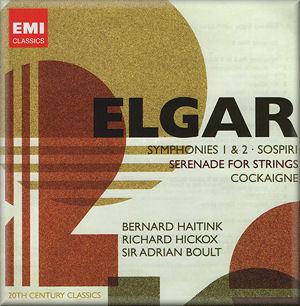 |
 |
|


alternatively
CD: MDT |
Sir Edward ELGAR
(1857-1934)
Symphony No 1 in A flat, Op. 55 [53:57]
Pomp and Circumstance March No. 5, Op. 39 [5:29]
Sospiri, Op. 70 [5:34]
Serenade for Strings in E minor, Op. 20 [12:48]
Symphony No 2 in E flat, Op. 63 [59:06]
Overture: Cockaigne (In London Town)
 Philharmonia Orchestra/Bernard Haitink (Sys)
Philharmonia Orchestra/Bernard Haitink (Sys)
City of London Sinfonia/Richard Hickox (Sospiri, Serenade)
London Philharmonic Orchestra/Sir Adrian Boult (Cockaigne)
rec. 20-21 April 1983, Walthamstow Assembly Hall, London (Sy 1,
March); 22-23 March, 1984, No 1 Studio, Abbey Road, London (Sy 2)
; 16, 22 February 1984, St, Barnabas’s Church, Woodside Park,
London (Sospiri, Serenade); 29 September 1970, All Saints’
Church, Tooting, London (Cockaigne). All DDD except Cocakigne (ADD)
 EMI 20TH CENTURY CLASSICS 9072212 [77:49 + 73:58]
EMI 20TH CENTURY CLASSICS 9072212 [77:49 + 73:58] 
|
|
|
Bernard Haitink has made a sterling contribution to the musical
life of the UK over the last four decades or so, presiding with
distinction at various times over the London Philharmonic Orchestra,
at Glyndebourne and at the Royal Opera House as well as being
an honoured guest on the podia of most of the other major London
orchestras. And in addition to contributing to British musical
he has absorbed the music itself, conducting and recording works
by composers such as Britten, Vaughan Williams - I find much
to admire in his recordings of the symphonies - and Walton.
I recall his recording of the Elgar Second Symphony - though
it’s now many years since I last heard it - but his recording
of the First is new to me. I enjoyed much of it though I have
some doubts about the first movement. The motto theme is unfolded
at a stately pace - more broadly than I can ever recall - and
the succeeding allegro is conceived in quite a spacious
way. Haitink achieves considerable clarity through his patient
approach and here, and throughout both symphonies one has a
strong sense of structure, but I think he misses the fire and
drive that the music of this first movement requires. Haitink
takes 22:02 for this movement. Just for comparison I investigated
a few versions at random from those on my shelves - choosing
only studio-made versions - and it’s instructive to see
that Barbirolli, in his fairly spacious 1962 account (EMI),
comes closest to Haitink at 21:39. Sir Mark Elder (2001, Hallé)
requires 20:05 while Sir Adrian Boult (1976, EMI) takes 17:31
and Vernon Handley (1979, Classics for Pleasure) is even swifter,
clocking in at 17:03. I’ve never felt any lack of space
or presence in either the Boult or Handley readings but, listening
to Haitink, I felt that the music didn’t have quite sufficient
momentum, though I admired a great deal about the reading
Thereafter his way with the piece is much more to my taste.
The Allegro molto scurries along as it should and the
account of the finale is impressive. The highlight, however,
is a finely sung performance of the Adagio. The nobility
of this music suits Haitink very well and his reading has poetry
and authority.
Returning to his reading of the Second Symphony after a long
gap I was mildly surprised to find that the story was rather
the same as in the First in that my reservations centred around
the first movement and that the most distinguished part of the
interpretation was the slow movement. (The First was recorded
about a year before the Second).) The first movement opens promisingly
and overall I think Haitink brings off the faster music in this
movement well. I’m less sure about the passages of slower,
more wistful music, however. I feel that Haitink lingers just
too much in these sections and at times one feels the music
is coming perilously close to getting becalmed. The elegiac
Larghetto is another matter. Haitink’s approach
seems just right, blending sorrow and dignity. The scherzo is
full of vigour and builds to an exciting climax. The performance
of the finale is also a success: Haitink seems in tune with
the music’s various moods and here, as elsewhere in both
symphonies, his conception of the music is admirably supported
through excellent playing by the Philharmonia.
The other miscellaneous Elgar pieces fill the discs generously.
Richard Hickox leads affectionate, warm performances of the
early Serenade and of Sospiri - what a gorgeous little
piece it is! Sir Adrian’s account of Cockaigne
is authoritative, though I have heard performances with a bit
more sparkle.
For all that they have to commend them I don’t think that
Haitink’s performances of the symphonies could be considered
as first choice, so anyone investing in recordings of these
works would be better advised to consider Handley or Elder.
That said, like everything that this fine conductor does, these
are thoughtful, well-considered and deeply musical accounts
of these great scores and I’m glad to have them in my
collection. The EMI recordings are good; the notes, in three
languages, are brief but adequate.
John Quinn
Masterwork Index: Symphony
1 ~~ Symphony
2
|
|

